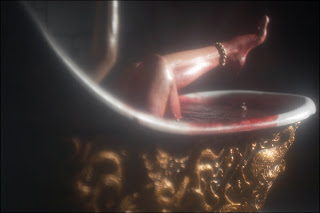
The case of Elizabeth Báthory inspired numerous stories during the 18th and 19th centuries. The most common motif of these works was that of the countess bathing in her victims' blood in order to retain beauty or youth. However, this legend only appeared in print for the first time in 1729 -- more than a hundred years after Báthory's death. At the beginning of the 19th century, this certainty was questioned, and sadistic pleasure was considered a far more plausible motive for Elizabeth Báthory's crimes. In 1817, the witness accounts (which had surfaced in 1765) were published for the first time, suggesting that the bloodbaths were legend. It seems that through history many women's deeds have been falsely attributed to vanity, and Countess Elizabeth was one of them.
According to all the trial testimony, her initial victims were the adolescent daughters of local peasants, many of whom were lured to Csejte by offers of well-paid work as maidservants in the castle. Later, she is said to have begun to kill daughters of the lesser gentry, who were sent to her gynaeceum by their parents to learn courtly etiquette. Abductions were said to have occurred as well.

In December of 1610, György Thurzó, then the second highest ranking dignitary after the King, went to Báthory's home of Csejte Castle. There he reportedly found one girl dead and one dying. They reported that another woman was found wounded, and still others locked up. He arrested Báthory, and four of her servants who were accused of being her accomplices. While Countess Elizabeth was put under house arrest (and remained so from that point on), King Matthias requested that she be sentenced to death. However, Thurzó successfully convinced the King that such an act would negatively affect the nobility. Hence, a trial was postponed indefinitely.
The descriptions of torture that emerged during the trials were often based on hearsay. The atrocities described most consistently included:
severe beatings over extended periods of time, often leading to death
burning or mutilation of hands, sometimes also of faces and genitalia
biting the flesh off the faces, arms and other bodily parts
freezing to death
surgery on victims, often fatal
starving of victims
sexual abuse
The use of needles was also mentioned by the collaborators in court.
Given the types of cruelty committed, and the fact that serial killers usually only kill whatever gender of person they're attracted to, one can assume Countess Elizabeth was a lesbian; what fueled her need to kill, however, is more of a mystery.